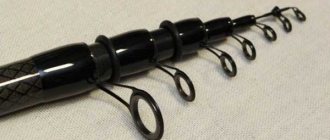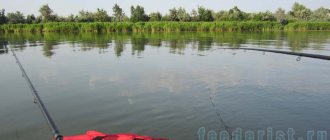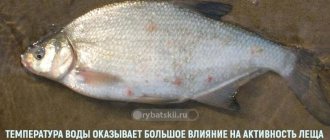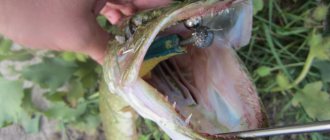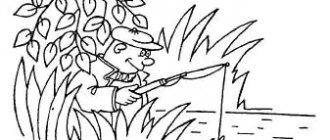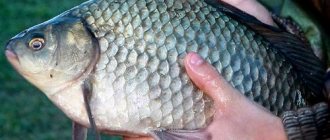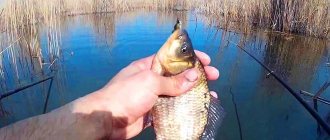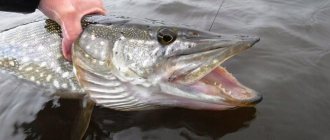Fishing with a Bolognese fishing rod, types of fishing
The main purpose of the Bolognese fishing rod is fishing in the current. There are three types of wiring
Free swimming is the simplest and most ineffective way. In this case, the tackle floats under the influence of the current, and we simply open the reel bracket and allow the fishing line to reel in, without affecting the wiring itself in any way. Rarely used in practice.
Holding (stepped retrieve) - the essence of this method is that the float should move at a speed lower than the speed of the current, because the fish will not chase the bait, but a slowly swimming bait will arouse its interest. How is fishing done with a Bolognese fishing rod? First, we throw the tackle a little higher from the place where we fed it, this is done for two reasons. Firstly, in order not to scare the fish once again, and secondly, because the tackle needs some time to reach the bottom, and in this case, when the float reaches the bait zone, the bait will go to the depth we need. Then, by slightly pulling the line, we slow down the movement of the float, at the same time, under the influence of the current, the hook rises from the bottom to the upper layers, then we release the float and the hook falls, this type of wiring is excellent for catching roach. While holding, the float will necessarily be gradually carried towards the shore, so we will periodically have to release the line, letting the float float freely and not allowing it to leave the bait zone. If, while holding, the float jumps out of the water or goes to the shore too quickly, this means that you are too zealous with the holding.
Wiring control
After casting, you need to swing the rod sideways and up, ensuring that the line from the tip of the rod immediately goes to the float without touching the water, although such an ideal tension is only possible when we use floats weighing 8 grams. and more. While fishing, you need to keep the rod raised up at an angle of 45 degrees, so that the line does not lie in the water, but goes directly to the float.
Fishing with a wire differs from holding in that the sinker and catch drag along the bottom, respectively, the speed of movement of the gear is less than the speed of the current and the bait will stand out against its background, while we also carry out holding.
If you have set the depth correctly, then with this method of wiring, the float antenna will be tilted towards the current. The disadvantage of this method is that if the bottom is snarled, then you will have frequent snags and breaks. If you set a short hook, you will catch fish that feed from the bottom, but if the hook is long, the current will lift the hook from the bottom and you will be able to catch fish that are standing in the water column. Read more about fly fishing here.
Bolognese equipment
This equipment is generally as simple as the usual float “ouda”, which has been used for fishing since the time of Sergei Timofeevich Aksakov. But here the version of the float rod is expanded by increasing the casting range, wiring and new fishing techniques. The Bolognese modernized fishing rod kit includes an additional spinning reel and floats with characteristics different from those of a conventional “float”, which will be discussed later. And the rest is all as usual: a rod, a large landing net, bait, a cage and, of course, spare hooks, lines, floats.
Depth sounding
To determine the depth and topography of the bottom, you can use an echo sounder; when you sail on a boat, you will immediately get a picture of the bottom and its inhabitants. You need to find a relatively flat bottom with some slight unevenness, as fish do not like perfectly smooth areas. True, this method is not suitable for all fishermen.
Therefore, the bottom relief is often determined by the float, for this all the weights are moved to one point, and it is better to remove the leash and hook so as not to tangle and damage the delicate tackle due to the unevenness of the bottom.
If the float goes smoothly and only rises or tilts in some places, then the bottom is flat with small tubercles, and it is on these tubercles that the sinker strikes against it (be sure to hold it in these areas, this allows the bait to pass through them without snagging). It is desirable that in the wiring areas there are from two to four such tubercles, because it is often near them that the bait accumulates and most of the bites occur. If the float is tilted or raised out of the water during the entire drive, then the depth is set too great and needs to be reduced.
In summary, if the float floats throughout and the antenna stands level, without rising or falling, then the depth is large, and it must be reduced, and then repeat the wiring, and if the float floats smoothly and rises only in some areas, then the depth set correctly.
After we have found an area with a relatively flat bottom and several tubercles, we need to make a couple of wires closer and further from the chosen place in order to determine the difference in depth near the wire site.
Fishing with a Bolognese fishing rod, choosing a fishing location
Before looking for a fishing spot, you need to study the habits of the fish you are going to hunt, what kind of bottom topography it likes, at what depth it stands, feeds from the bottom or in the water column, and based on this, choose areas for fishing.
In the spring you need to fish on small rivers and bays, since all the fish rush there for spawning. After spawning, it should be looked for at the mouth of the river, and in the summer in wide rivers and reservoirs. On lakes, before spawning, it stands at depth, during spawning in shallow water, and after spawning, when the heat sets in, it returns to a depth of 2-4 m.
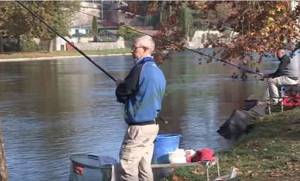
When fishing on a fast river, you need to look for areas where the current is weakened. When fishing on a river with a medium current, you need to pay attention to places where there is no current or, on the contrary, a stronger one. Quite promising fishing spots are areas where the river narrows, washed-out banks, riffles, whirlpools, and tree crowns hanging over the water.
It is also worth paying attention to the presence of vegetation in the fishing area, since the Bolognese rod is 6-7 meters long, and it will be inconvenient for you to fish under the canopy of trees.
Rod selection
When choosing a Bolognese fishing rod, you should be guided, first of all, by the places of intended fishing, and the size of the fish living there. For large bodies of water, with depths and currents above average, you should choose a long rod. The optimal length would be six to eight meters.
It will allow you to make long and very accurate casts. For small bodies of water, it will be important to choose a small fishing rod that will allow you to adapt to any shore conditions. You can easily cast even in conditions limited by grass and bushes.
Pay special attention to the material from which the form is made. Conventionally, they can be divided into composite materials and carbon fiber:
- Composite fishing rods are heavier and more rigid, but are relatively cheaper than carbon fiber. They should be used for fishing mainly large fish. This material is able to withstand heavy loads, handling any powerful blows. Less suitable for frequent casting and catching large numbers of small fish.
- Carbon fiber has significantly less weight, is more “biting”, and is capable of throwing the lightest equipment far. Perfectly handles the sharp blows of an average fish. Thanks to its flexibility, it allows you to make jewelry presentations of bait at medium and close distances. Less suitable for fishing large fish due to its fragility. The price is significantly higher than composite fiberglass. For example, your body of water is a small river or lake. The fish that live in this reservoir have a maximum weight of two kilograms. For these conditions, it makes sense to purchase a carbon fiber rod five meters long. Which will allow you to fish casting and under the shore, like a regular fly rod.
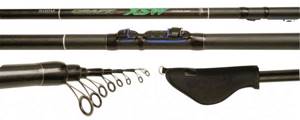
The next important parameter is the structure of the fishing rod. Conventionally, there are four tunings: ultrafast, fast, moderate, slow. When choosing a system, proceed from the following:
- Slow build. Suitable for fishing at close distances. The cast will be smooth, the hook will be a little blurry.
- The medium action of the blank is suitable for fishing at a distance of more than twenty meters.
- Fast and ultra-fast, used over long distances. These types of formations are capable of producing the longest cast possible, and significantly facilitating hooking at maximum throw.
Medium action, suitable for most conditions. The rod test is a parameter that indicates what maximum and minimum weight of equipment can be used on a given form. The balance of the rod is a very important parameter; it determines how comfortable it will lie in your hand. To check it, assemble the fishing rod and place it on your finger.
Try to find a position in which the form will take a strictly horizontal position. If this place is as close as possible to the reel seat, you can fish for hours without feeling tired.
How to cast
The simplest type of casting is the pendulum style , we grab the edge of the tackle near the hook, pull it so that the tip of the rod bends, then we move the form to the side (almost parallel to the shore) and release it, while returning the rod to its original position (perpendicular to the shore), lifting it at the same time. If our shore is overgrown with reeds, then we will not be able to make a side cast, so we also tighten the tackle and release it, while only lifting the rod up. If the wind is quite strong and we need to push it, then we should cast over the head, and we must be careful, there should not be a crown of trees or wires above you.
Fishing with a Bolognese fishing rod, features of bait
Fishing with a Bolognese fishing rod in the current has its own characteristics in bait tactics. We sculpt the balls that are hard and heavy; they should not break on the water when they fall. Usually, the starting feeding is carried out with 6-8 balls the size of an orange, which are thrown quite closely. We do not throw the bait opposite us, but a little further downstream. After catching one or two large fish, you need to additionally throw one bait ball; if you are not catching large fish or large fish do not bite so often, then the frequency of supplementary feeding is approximately every half hour. When you fish in a strong current, the frequency of supplementary feeding is more frequent, approximately every 15 minutes. It happens that you abandoned the supplementary feeding ball and the bite disappeared for a while and resumed only after 10 minutes; in this case, next time you need to supplement the feeding with smaller balls.
Bolognese floats
For fishing in currents, floats are used that are slightly different from the floats of a conventional float or fly rod used on ponds and lakes, since fishing often takes place in strong currents. Therefore, the shape of Bolognese floats is more often in the form of a sphere or a drop. The line mount is also different. On the fly rod floats, the line is threaded through a wire loop. On the Bolognese rig, the mount is a durable tube mounted in the float. This is necessary so that the fastening can withstand hooking in a strong current, when the force of the stream further increases the load on the tackle. If you use fly rod floats, the fishing line will simply pull the fastening loop out of the body of the float. Imagine the float of a fly rod floating twenty meters from you, but on a long retrieve, like a lap dog. It swayed, tilted and sank obliquely under the water, leaving only the tip of the antenna on top. A strong pull-hook and... only the wire fastening ring dangles on the fishing line. The load on the tackle is too great at a great distance from the fisherman. I must admit, such incidents happened to me more than once when I used ordinary floats. Especially when the bite was sluggish, and every rare bite was worth its weight in gold. Well, and, of course, all the passion, excitement and evil power were invested in hooking. But even with careful hooking, the float tackle may not hold up.
There are also differences in the antenna of the float, since fishing can take place at a great distance from the angler, and he simply will not see the bite if the tip of the float is thin. And this is possible, since the distance can be about 25 meters. Therefore, the antenna of Bolognese floats is much thicker and covers two-thirds of the float. When the most successful method of Bolognese fishing, called "holding", is used, the antenna usually floats even higher to the surface, making it more visible and at a greater distance. Sometimes, when the current is too strong, the floats are slightly underloaded.
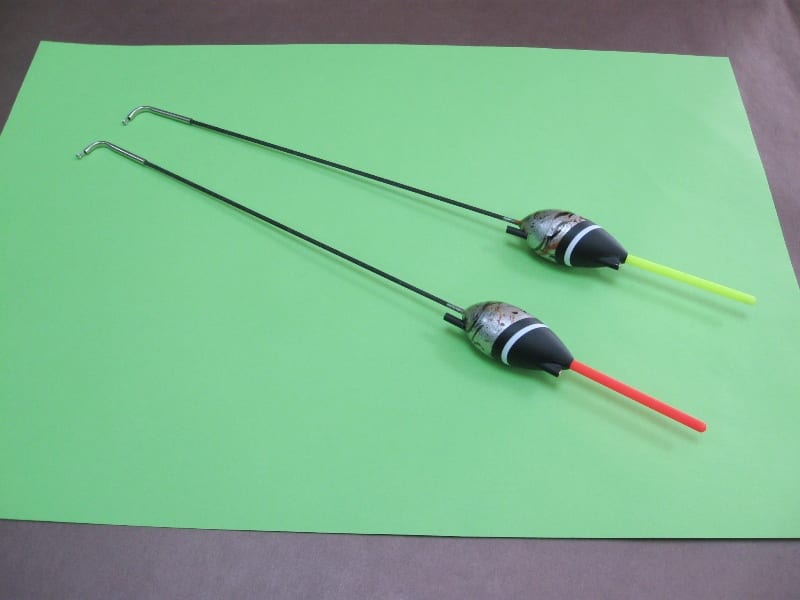
Floats in the form of a classic spindle or “needle” floats
Such floats are quite often used in Bologna rigs. They are relatively stable in the current, and with a thick antenna they are clearly visible from afar. But, nevertheless, more often in use, products are spherical in shape and weighing about 5 grams, having a long fiberglass or carbon fiber keel. Such light keels are sensitive to all touches of the hook to the bottom during retrieving. For the flow, the tackle is surrounded with light olives and an additional set of pellets on the underside. On slow-water ponds or on rivers with weak currents, the tackle is loaded using only pellets, selecting their number to suit the conditions and depth of a particular place.
Although the equipment is also called running, it is best to use floats with a blind fixed mount. Such equipment is more controllable and sensitive. It allows you to use a successful fishing method called “holding”, which is considered the most effective among fishing techniques with a Bolognese fishing rod.
Sliding floats are needed for fishing at great depths
There is an unspoken rule: a blind mount for a float is used in cases where the depth in the area of the reservoir chosen for fishing is less than the length of the rod. Naturally, at a depth exceeding the length of the rod, casting a tackle with a blind float mount is impossible. And here you can’t do without a sliding float.
